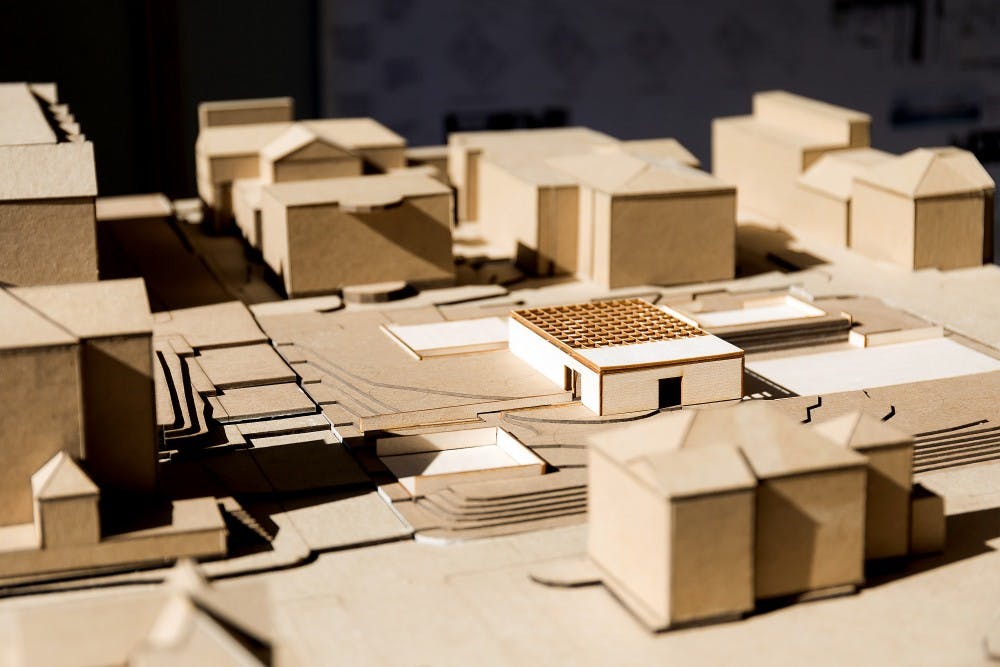Thirteen graduate and undergraduate students from the University’s School of Architecture have created proposals to redesign Emancipation Park in downtown Charlottesville. The designs are on display in CitySpace, a city-owned meeting space, on the Downtown Mall.
The redesign ideas were part of a six-credit Research Studio, open to both undergraduate and graduate students, taught by Architecture Prof. Karen Van Lengen. The class is described as an advanced studio where students explore complex issues and sites, often through interdisciplinary design research. After last year’s renaming of Emancipation Park, formerly known as Lee Park, and the vote by Charlottesville City Council to remove the statue of Confederate General Robert E. Lee from the park, she wanted at least one class to focus on the future of the park. She said she prompted her students to think of the effects of either keeping or taking down the statue.
Mert Kansu, a graduate Architecture student and one of the project creators, said the studio was originally centered around sound and how it affects a physical space. The focus of the studio shifted a little, however, following the events of Aug. 11 and 12, when white nationalists held a torch lit march through Grounds and descended on Charlottesville for the deadly Unite the Right rally.
“The studio’s main goal was … exploring sound and how it kind of informs the space,” Kansu said. “So we wanted to create a space, a forum, in Charlottesville but after the events [of Aug. 11 and 12] took place, the studio was also invested in reimagining Emancipation Park.”
City Council approved the placement of tarps over the statues of Lee and Confederate Gen. Thomas “Stonewall” Jackson in nearby Justice Park shortly after the events of Aug. 11 and 12. In September, City Council unanimously voted to remove the statue of Jackson.
The City is facing an ongoing lawsuit, filed in March 2017 by 11 community members and two organizations, against the placement of the tarps and the removal of the statues. The plaintiffs argue removing the statues would violate Virginia law which protects memorials for war veterans. In the latest phase of the lawsuit, Judge Richard E. Moore postponed a decision concerning the status of the tarps during a hearing at Charlottesville Circuit Court Monday.
Presented with the options to remove or keep the statue or alter it to change its meaning, Van Lengen encouraged her students to consider their redesign ideas.
“It became an individual response by each of the students to think about that issue and what it means with the history of the community and the history of African-American culture in America,” Van Lengen said. “And, so, getting ready for that, they did a lot of research.”
The project started in the fall semester and students worked on it through early December. In order to make a decision about the future of the statue and the park, Van Lengen’s students conducted research on the history of the Charlottesville community and African-American culture in America. Students interviewed Charlottesville residents and read the report from the city’s Blue Ribbon Commission on Race, Memorials and Public Spaces, which presents an analysis of the legacy of slavery and racism in Charlottesville memorials and public spaces and recommendations on how to address that history.
City Council formed the Commission in May 2016 to address local concerns regarding the statues of the confederate generals downtown.
Fourth-year Architecture student Sarah Schaefer said she’s not too familiar with the history, but she wanted the statue to be removed while revealing and preserving the context behind it.
“What I started thinking of was trees — when they’re uprooted, you can kind of see the force that takes down the tree,” Schaefer said. “In the whole process of a tree being uprooted, it also lifts the land around it, and it kind of reveals the underworkings, something you wouldn’t normally see … I kind of went on that metaphor, for the statue as a tree, and it has all these roots.”
Schaefer said her redesign would show what forced down the statue, while telling unheard stories related to the confederacy. Her main goal with the project was to reveal, in accordance with the motif of storytelling within the project.
As Kansu noted, the project also included an element of sound design and its relevance to architecture. Van Lengen said students collected stories of everyday people in Charlottesville about significant areas in the town.
“Many students decided to play recordings in the site, installations, to prompt discussion, sort of face-to-face discussion in the park, so the communicative aspects of the project were very important,” Van Lengen said.
The designs are open to the public and will remain on display in CitySpace for the month of February.







